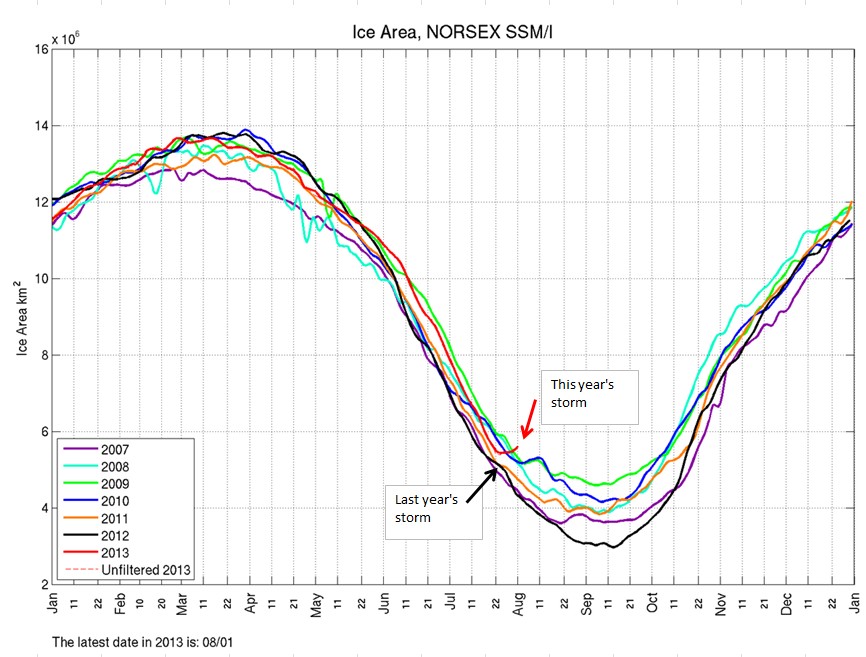Back when the sea was thick and lasted for years, cyclones tended to spread the ice out and actually increase its extent, said Julienne Stroeve of the National Snow and Ice Data Center in Boulder, Colo. Now, when ice gets spread out, it simply breaks up and disappears.
“As our ice cover has thinned, some of our old rules are changing,” said Stroeve.
Summer cyclone chewing up Canada’s Arctic sea ice | CTV News
This year’s cyclone spread the ice out and increased its extent.



This is for Julienne
http://www.youtube.com/watch?v=5_H-LY4Jb2M
so, could you say ice area is at a record high??
I beg to differ slightly . . . the above graph is Sea Ice Area – not Sea Ice Extent. Norsex have both. And both show a uptick. The Sea Ice Area uptick is more dramatic than the Sea Ice Extent uptick. This seems to indicate to me that it is mor than just ‘speading out’.
I woud hazard a guessthat the recent storm has been a cold one and that a lot of the surface melt pools have refrozen – as recently occurred at the NPEO. http://psc.apl.washington.edu/northpole/WebCams.html
Norsex (and others) admit that their algorithms have difficulty differentiating melt polls from exposed ocean.
State-of-the-art climate “science” 2007:
http://news.bbc.co.uk/2/hi/7139797.stm
“Our projection of 2013 for the removal of ice in summer is not accounting for the last two minima, in 2005 and 2007,” the researcher (Professor Maslowski) from the Naval Postgraduate School, Monterey, California, explained to the BBC. “So given that fact, you can argue that may be our projection of 2013 is already too conservative.”
Boy-oh-boy they blew that one big-time.
“Using supercomputers to crunch through possible future outcomes has become a standard part of climate science in recent years.”
Yeah, uh huh. Climate models. Pffft. Those haven’t worked out too well!
The good professor continues, because what the hell, he’s on a roll; and this is how it’s done when you’re a rock-star-grade climate scientist partying with your pals in the media:
“We use a high-resolution regional model for the Arctic Ocean and sea ice forced with realistic atmospheric data. This way, we get much more realistic forcing, from above by the atmosphere and from the bottom by the ocean.”
Of course they do. They are professionals, that is, they get paid for these precious, neigh, invaluable insights.
Professor Peter Wadhams from Cambridge University, UK, is an expert on Arctic ice. … He cited the ice-albedo feedback effect in which open water receives more solar radiation, which in turn leads to additional warming and further melting. Professor Wadhams said the Arctic was now being set up for further ice loss in the coming years…”In the end, it will just melt away quite suddenly.”
Have either of these esteemed members of the academy ever predicted anything; I mean accurately predicted anything?
Just wondering.
Prediction: This years Arctic ice talking point for the warmista will be ‘increasing inter-annual oscillations’. Then next year, when the ice area/extent is higher again, they’ll tell us to get ready for the big melt in 2016, which won’t happen, again.
They will blame the excess Arctic ice on missing Arctic ice.
Nice Hockey stick has formed on that chart..
These ass wipes need to be laughed at often and heartily day in and day out until they confess that they are indeed, truly full-of-shit -:)
Or crawl under a rock, never to be heard from again.